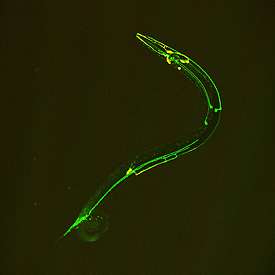A U-M biologist and his colleagues have found that the strategies used by the tiny C. elegans roundworm to control its motions are remarkably similar to those used by the human brain to command movement of eyes, arms and legs.
C. elegans, a nematode about 1 millimeter in length, is one of the most widely used animals in biological research. In the Nov. 11 edition of the journal Cell, U-M’s Shawn Xu and his colleagues show that the roundworm uses two neural circuits that respectively act as a gas pedal and a brake release to change direction. The gas pedal circuit has been known for years and was thought to be the only neural pathway involved.

Green and yellow fluorescence mark the processes and cell bodies of some C. elegans neurons. Photo courtesy Xu lab.
Using a multidisciplinary approach, Xu’s team has found that a second, previously unknown neural pathway also is involved. It acts like releasing the brake pedal on your car to allow motion. The human brain uses both the gas pedal and brake release circuits to command the movement of eyes, arms and legs.
“Our results show that distantly related organisms with anatomically distinct nervous systems may adopt similar strategies for motor control,” Xu says. “This new information about the nematode’s brain can be used to provide insights into how the human brain — and the brains of many other organisms — works,” says Xu, a research associate professor at the Life Sciences Institute (LSI) and an associate professor of molecular and integrative physiology at the Medical School.
Specifically, the new C. elegans findings are expected to help scientists better understand human neurodegenerative diseases — such as Parkinson’s and Huntington’s — that involve movement disorders, Xu says.
The C. elegans nervous system contains 302 nerve cells called neurons, while the human brain contains about 100 billion neurons. C. elegans is the only organism whose entire nervous system — all the neurons and the connections between them — has been mapped.
In the past, scientists have relied on that neural wiring map to draw conclusions about how these worms control movement. Some of the conclusions turned out to be incorrect, because “the structural map is not the whole story,” Xu says.
“Our current view on the circuitry needs to be significantly revised,” he says.
To get a more complete picture, it’s necessary to observe and record the activity of individual neurons while the animal is engaged in a specific type of behavior, such as changing its direction of motion.
Testing revealed the presence of a previously unknown, RIM-mediated parallel circuit that promotes motion changes in C. elegans. The brake pedal circuit identified in this study is functionally analogous to those found in humans and other mammals.
“The significance of these findings is that Dr. Xu and his colleagues have established the worm C. elegans as the premier model system for identifying the neural circuitry that mediates behavior in animals in their natural state — freely moving,” says Laurie Tompkins, acting director of the Division of Genetics and Developmental Biology at the National Institute of General Medical Sciences.
“They also made an unexpected discovery, which is that worms are similar to mammals, which have much more complicated nervous systems, in that reversal — moving backwards — is controlled by two neural circuits,” Tompkins says.
U-M co-authors of include Beverly Piggott of LSI and the Department of Molecular and Integrative Physiology, and Jie Liu of LSI.

